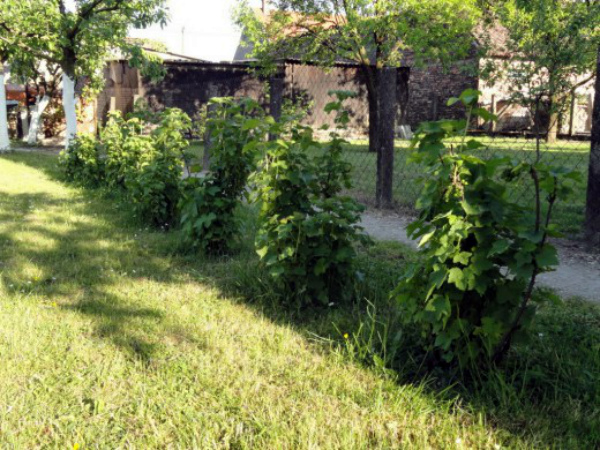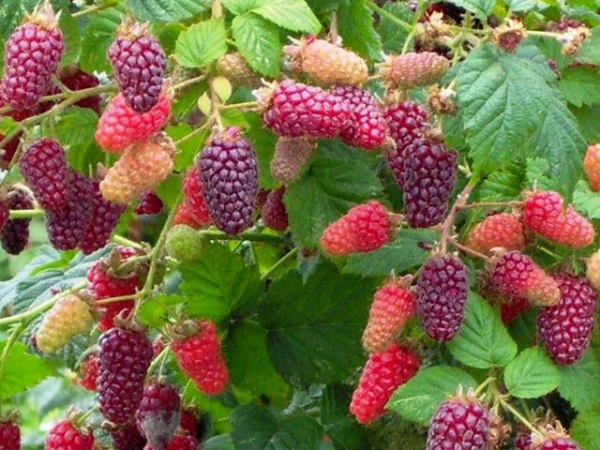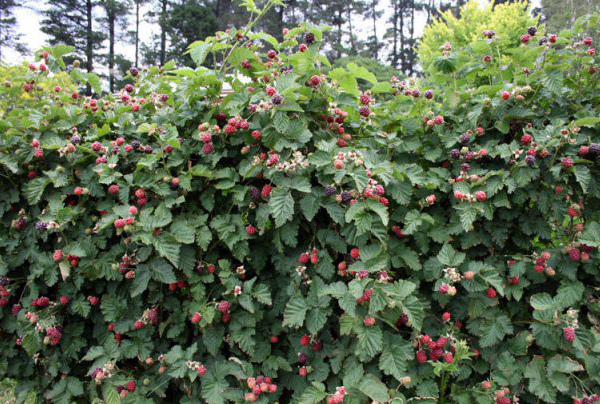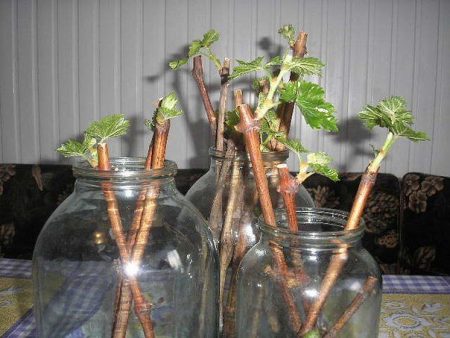Blackberry Tayberry: the subtleties of planting and care
Content
Description of the variety
Hybrid "Tayberry" (or "Tayberry") in Western Europe and North America is used for industrial cultivation of vitamin fruits. In Europe, up to 20 tons of berries are obtained from 1 hectare. When cultivated on personal and small farm plots in our climatic conditions, the crop is harvested less, but it is quite easy to grow the amount necessary for the needs of your family or for quick sale on the market.
The yield of one bush, depending on its age and volume, ranges from 3 to 5 kg. Of course, modern blackberry varieties give a much larger harvest, but the taste of large ruby berries, which is described as sweet raspberry with a wonderful fruity aftertaste, explains the delight of those who have already settled a bush of this raspberry-blackberry hybrid on their site.
The creeping shoots of the Tayberry Ezemalina grow up to 3 meters, and if they are not limited, then up to 5 meters. They are strong and flexible, they can be easily braided on a wire, and then removed in autumn, rolled up for cleaning for the winter. Fruiting shoots of the second year acquire a light burgundy color, and young ones - green. The branches are covered with small but numerous thorns, they are more like soft crimson thorns than large and sharp blackberry thorns.
The bush gives replacement shoots in the first year only 3-4, later - up to 6 pieces. Ruby-red fruits have an elongated shape, they grow up to 5 cm long and weigh 7-10 g. Bright burgundy (ruby) color testifies to technical maturity, after a few days it acquires a darker shade and full ripeness. This hybrid of raspberries compares favorably with blackberries - at the stage of full ripening, the berries reveal all the richness of taste and aroma. Fruiting lasts a month, usually starting in mid-June.
The bush looks very decorative at all stages of growth: its slightly corrugated trifoliate leaves are dark green in color, large white flowers are a pale pink hue, the fruits become more and more vibrant every day. The berries are easy to pick, despite the thorny branches, they do not hide under the leaves, but there is a certain danger here - they can bake in too hot sun. The berries are quite mature, suitable for transportation, they are perfectly preserved for several days.
It is very important that this ezemalina is resistant to the main diseases of its parents and easily adapts to the conditions of any climate. Her winter hardiness is average, it is advisable to cover the bush even in the southern regions, because without snow the entire above-ground part of the bush can freeze out. The disadvantages of this raspberry / blackberry hybrid are considered to be a small yield and thorns.
British breeders 30 years ago created another hybrid, the characteristics of which largely coincide with the "Tayberry", called it "Buckingham Tayberry". This new hybrid of blackberries and raspberries does not have thorns, bears fruit for up to 6 weeks, its berries are somewhat sour than a thorny relative, but they grow up to 8 cm and gain 15 g in weight.The yield of the new hybrid has also increased.
Video "Raspberry Tayberry"
Take a look at the Tayberry Raspberry / Blackberry Hybrid Review and learn more about its characteristics and growing experiences.
Preparing for landing
You can plant ezemalina on the site in spring or autumn. A seedling can be taken even in the middle of summer, but more often it is planted in a permanent place of growth in the spring, as soon as the soil allows, or in the fall after the end of the growing season. It is advisable to prepare the soil in advance. This hybrid is not very picky about its composition, but in order to grow a healthy bush and get a rich harvest, it is advisable to plant it in nutritious loam. So if a seedling is expected to be planted in the spring, already in the fall after harvesting, it is worth finding an open place protected from drafts, clear the area of grass, dig up a shovel bayonet to the depth, pick out all the roots, stones, debris. In heavy soil, it is worth adding peat or sand for better breathability. If at this place there is a risk of accumulation of melt water or stagnation of water for another reason, it is worth preparing drainage.
You can apply fertilizer to the entire area of the site, especially if you plan to plant several bushes or 1 square meter for one bush. Usually they bring in several buckets of compost or humus, add lime to acidic soil (this hybrid, like its parents, prefers neutral soil) or just wood ash. Or you can dig a hole (for each bush), put fertilizers in it, sprinkle it with earth and leave it until spring. When planting in spring, fertilizers are immediately laid in the pits, only you need to make sure that there is a layer of earth between them and the roots, otherwise the roots may get burned.
Landing technology
When choosing planting material, you should carefully examine the roots and shoots - they must be alive, not dry, without damage. It is advisable to keep the roots in the ground, with an earthen clod and lower them into a hole.
A hole is dug 0.5 m in diameter and depth, the seedling is lowered a couple of centimeters lower than it grew earlier, but the root collar must necessarily remain above the ground.
Several bushes are planted in rows, leaving up to 2 m of free space between them, between plants in a row it is worth leaving gaps of up to 1.5 m.The place should be open, but ideal conditions, especially if a hot summer is expected, is maximum sunlight in the morning and evening hours, and in the afternoon it is desirable to provide partial shade.
After the roots are lowered into a prepared hole, covered with earth and watered abundantly, gardeners usually mulch the near-stem area with peat, compost, hay - this will delay the evaporation of moisture, keep the temperature, and prevent weeds from growing. Shoots are cut to a living bud, leaving 30 cm from the ground. If the planting takes place in the fall, then the plant is further covered for the winter, but so that it is not very hot, otherwise the buds can become resistant.
Care features
Ezhemalina, like her closest relatives, loves moisture, but not stagnant water, so watering should be sufficient, drought will add acid to the fruits, and waterlogging near the roots can lead to their decay. The soil around the stems must be loosened, but the roots must not be damaged. Weeds around the bushes must be removed in a timely manner, grass and fallen leaves must not be left, so as not to create conditions for the reproduction of pests and fungal spores - pathogens.
In the spring, before the buds come to life, winter insulation is removed, shoots are examined, sanitary pruning is carried out. After that, shoots are tied up on trellises. In the summer, some gardeners shorten the shoots of the creeping blackberry to stimulate the growth of fruit twigs, the Tayberry hybrid does not need this. The next pruning should be in the fall, when the shoots are removed from the trellises, unwound, cut off those that bear fruit, examine the shoots of the first year, remove the weak ones, shorten the good ones by a third and cover them for the winter.When pruning, the bushes are normalized: in the fall, they leave from 7 to 9 shoots of replacement, and in the spring they remove those that have suffered from winter or simply the weakest, so that 4-6 shoots remain for fruiting. A larger number of them will not give a greater yield, just the berries may become smaller, and the plant itself is weaker.
It is convenient to tie up shoots with a fan - fruiting branches are fixed in one direction, and young ones in the other. Some gardeners suggest a bowl shape to prevent thickening so that all twigs, flowers and fruits get enough air and light. In hot summer, under the scorching rays of the sun, ripe berries can bake or flow. To prevent this from happening, a net is stretched over the bush, creating partial shade. It is good if the plant is protected from too aggressive sun in the middle of the day.
Fertilize if necessary. In the spring, humus or a complex fertilizer rich in nitrogen is usually applied. Further, during flowering and ripening of fruits, the plant no longer needs so much nitrogen, if fertilizing is applied, then the emphasis is on potassium-containing compounds.
Reproduction
Ezhemalina propagates by layers that take root easily. This hybrid does not give root offspring, except when dividing the root. You can root cuttings cut in the fall when shortening the shoots.
Diseases and pests
Ezhemalina "Tayberry" shows amazing resistance to traditional diseases of blackberries and raspberries. The main pests, hungry for sweet berries, appear after fruiting. Aphids can be a threat. It is necessary to carefully examine the shoots, if insects are found, it is necessary to urgently cut and destroy the infected parts, and treat the whole plant with an infusion of ash or tobacco. Usually, it does not come to chemicals.
Video "Raspberryberry Buckingham Tiberry"
This video will tell you about the history of the Buckingham Tiberry raspberry / blackberry hybrid and its benefits.








